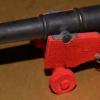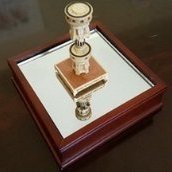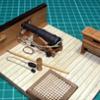-
Posts
1,763 -
Joined
-
Last visited
Reputation Activity
-
 Mark P got a reaction from thibaultron in Fascinating history lesson
Mark P got a reaction from thibaultron in Fascinating history lesson
Hi;
Thank you for posting this. It is certainly interesting.
All the best,
Mark P
-
 Mark P got a reaction from mtaylor in Royal Caroline, deck covering
Mark P got a reaction from mtaylor in Royal Caroline, deck covering
Greetings everyone;
Unfortunately it appears that the link above does not work properly. The photos of the model can also be found on Charles Miller's website, auction catalogue for sale number 12, 30th October 2013. After a couple of clicks it is possible to get to a page-turning online catalogue. The model in question is on page 106 & 107.
Incidentally, it appears that Charles Miller's catalogues are well worth looking at for Naval and maritime items. They hold twice-yearly auctions of fine art, models, and memorabilia. With prices that are well beyond the pockets of most people, unfortunately.
All the best,
Mark P
-
 Mark P got a reaction from Archi in Royal Caroline, deck covering
Mark P got a reaction from Archi in Royal Caroline, deck covering
Hi Frankie;
thank you for posting the picture of Victory's cabin. I must go there again, not been for many years! I have seen the chequer-board pattern on the decks of cabins in models, as well. So painted canvas was used internally, without doubt.
I think, though, that we must at all times remember that 'absence of evidence is not evidence of absence'.
Doreltomin has sent me a link to a contemporary model of the Naval Yacht 'Old Portsmouth' from an auction catalogue. This model is attributed to the yacht in the year 1752. The entirety of the upper decks is covered in the same pattern of painted chequerboard, presumably on paper in the model's case, but it must represent canvas on the real vessel. There cannot have been any alternative material to use in those times.
I have also seen a contemporary model of an admiral's barge with painted canvas on the deck planking, at the NMM's model store.
I will try to put a link here: http://www.charlesmillerltd.com/catalogues/ms301013/lot0347.html
Doreltomin has also carried out research at the National Archive at Kew, into the building of the Royal Yacht 'Henrietta' in 1679. A letter from her master shipwright is there, in which he writes complaining about the late arrival of the copper for the kitchen funnel, and for coppering the mast.
I think that these two items of evidence must give rise to an acceptance that perhaps Royal Yachts and Naval Yachts at least, and maybe some other small vessels sometimes had painted canvas deck coverings, and/or (Speedwelll, as above, post #27, thanks Druxey) copper mast funnels at deck level. Regarding the mast funnels, it is also beyond doubt that in every painting of the Royal Caroline I have seen (four of them) in which it is possible to make out the lower masts, these are a pinky-red colour for the first 5 feet or so. I am happy to accept Doreltomin's written letter as evidence that this represents a copper funnel.
I will also carry out further research into Royal Caroline myself, and will see if there is any more mention of such things.
All the best,
Mark
-
 Mark P got a reaction from mtaylor in Royal Caroline, deck covering
Mark P got a reaction from mtaylor in Royal Caroline, deck covering
Hi Frankie;
thank you for posting the picture of Victory's cabin. I must go there again, not been for many years! I have seen the chequer-board pattern on the decks of cabins in models, as well. So painted canvas was used internally, without doubt.
I think, though, that we must at all times remember that 'absence of evidence is not evidence of absence'.
Doreltomin has sent me a link to a contemporary model of the Naval Yacht 'Old Portsmouth' from an auction catalogue. This model is attributed to the yacht in the year 1752. The entirety of the upper decks is covered in the same pattern of painted chequerboard, presumably on paper in the model's case, but it must represent canvas on the real vessel. There cannot have been any alternative material to use in those times.
I have also seen a contemporary model of an admiral's barge with painted canvas on the deck planking, at the NMM's model store.
I will try to put a link here: http://www.charlesmillerltd.com/catalogues/ms301013/lot0347.html
Doreltomin has also carried out research at the National Archive at Kew, into the building of the Royal Yacht 'Henrietta' in 1679. A letter from her master shipwright is there, in which he writes complaining about the late arrival of the copper for the kitchen funnel, and for coppering the mast.
I think that these two items of evidence must give rise to an acceptance that perhaps Royal Yachts and Naval Yachts at least, and maybe some other small vessels sometimes had painted canvas deck coverings, and/or (Speedwelll, as above, post #27, thanks Druxey) copper mast funnels at deck level. Regarding the mast funnels, it is also beyond doubt that in every painting of the Royal Caroline I have seen (four of them) in which it is possible to make out the lower masts, these are a pinky-red colour for the first 5 feet or so. I am happy to accept Doreltomin's written letter as evidence that this represents a copper funnel.
I will also carry out further research into Royal Caroline myself, and will see if there is any more mention of such things.
All the best,
Mark
-
 Mark P got a reaction from mtaylor in Disappearing lines in drawing
Mark P got a reaction from mtaylor in Disappearing lines in drawing
Greetings gentlemen;
thank you for the suggestion. I have tried re-booting, with no success.
However, I have now created a new drawing, copied into it all the lines I have drawn in the original CAD drawing, and then imported a fresh copy of the original underlay draught to work on top of.
This has been successful, so far, and the arcs and other shapes appear during construction, as 'ghost' lines, as they always did previously.
Per: I have tried to check the nodes, but they are many. Additionally, there is no hidden layer or object that I know of in this drawing. However, I will keep your comment in mind, and try to find out more about this kind of problem.
All the best,
Mark P
-
 Mark P got a reaction from Nirvana in Disappearing lines in drawing
Mark P got a reaction from Nirvana in Disappearing lines in drawing
Hi Jud, and thanks for the explanation.
The thing is, I am using three points (as mentioned in the first post) which is AutoCAD's default to draw arcs. Normally, after you define the beginning and the end, a ghost image of the arc appears, and changes radius according to where you move the cursor. The advantage of this is that it is possible to position the arc over those on the original draught and get a close fit, then click to lock the third point, after which the arc becomes a firm object.
The problem now is that the 'ghost' arc is no longer visible, and without seeing it, I have no idea of where to click for the third point.
All the best,
Mark
-
 Mark P got a reaction from mtaylor in Disappearing lines in drawing
Mark P got a reaction from mtaylor in Disappearing lines in drawing
Hi Jud, and thanks for the explanation.
The thing is, I am using three points (as mentioned in the first post) which is AutoCAD's default to draw arcs. Normally, after you define the beginning and the end, a ghost image of the arc appears, and changes radius according to where you move the cursor. The advantage of this is that it is possible to position the arc over those on the original draught and get a close fit, then click to lock the third point, after which the arc becomes a firm object.
The problem now is that the 'ghost' arc is no longer visible, and without seeing it, I have no idea of where to click for the third point.
All the best,
Mark
-
 Mark P got a reaction from jud in Disappearing lines in drawing
Mark P got a reaction from jud in Disappearing lines in drawing
Hi Jud, and thanks for the explanation.
The thing is, I am using three points (as mentioned in the first post) which is AutoCAD's default to draw arcs. Normally, after you define the beginning and the end, a ghost image of the arc appears, and changes radius according to where you move the cursor. The advantage of this is that it is possible to position the arc over those on the original draught and get a close fit, then click to lock the third point, after which the arc becomes a firm object.
The problem now is that the 'ghost' arc is no longer visible, and without seeing it, I have no idea of where to click for the third point.
All the best,
Mark
-
 Mark P got a reaction from mtaylor in Disappearing lines in drawing
Mark P got a reaction from mtaylor in Disappearing lines in drawing
Hi Per;
Thank you for the comment. I will look into this, and see what I can do. I think you mean 'nodes' by the way? Thank you for your help.
Mark: thank you for the thought. I don't think I have done this, but I will check. I think what you are referring to is what is called 'model space' and 'paper space' now. Thank you again.
All the best,
Mark P
-
 Mark P got a reaction from mtaylor in Disappearing lines in drawing
Mark P got a reaction from mtaylor in Disappearing lines in drawing
I have opened a new drawing and inserted a fresh background draught. If I then attempt to draw an arc or circle, this is fully visible during construction.
It would appear that somehow the attributes or properties of the inserted underlay in the first drawing have been altered in some way.
I hope that someone out there can suggest a possible reason, or I will have to start again; not a pleasant thought.
All the best,
Mark P
-
 Mark P got a reaction from mtaylor in Disappearing lines in drawing
Mark P got a reaction from mtaylor in Disappearing lines in drawing
Hi Don;
Thank you for what is an eminently sensible suggestion. I have changed the layer of the underlay to a completely new, dedicated layer. Unfortunately, nothing else has changed.
The biggest puzzle for me here is that it was working fine, with any arc visible during construction, and then for some reason they stopped being so.
Thanks again,
Mark P
-
 Mark P got a reaction from mtaylor in Disappearing lines in drawing
Mark P got a reaction from mtaylor in Disappearing lines in drawing
Hi Chuck;
Thank you for the advice.
'Something strange is happening' has been removed, and a more apt title created.
All the best,
Mark P
-
 Mark P got a reaction from mtaylor in Belaying of Reefing Tackles Query
Mark P got a reaction from mtaylor in Belaying of Reefing Tackles Query
Hi Banyan;
I have had a look in Lees and Marquardt, and both of them say that the reef tackle fall led down to the deck.
All the best,
Mark P
-
 Mark P got a reaction from mtaylor in Royal Caroline, deck covering
Mark P got a reaction from mtaylor in Royal Caroline, deck covering
Hi FatFingers;
Thank you for your reply, and for the time and trouble you have gone to to search these out.
I have a larger copy of the Bonhams image, but even at quite close quarters it is difficult to make out the deck, as only a small area of the fo'c's'le is visible. The deck here could be grey, or it could be planking in the shadow. Not really possible to be sure, as the viewpoint is low, and the deck is nearly end-on. This painting actually shows her later in her career, as Royal Charlotte.
The painting in the Victoria Gallery in Bath is a panoramic view of the arrival of Princess Charlotte, and Royal Caroline is not greatly detailed (she had been re-named Royal Charlotte for this event)
Your information about oilcloth is welcome. I have seen the name many times, but was never sure how it was made; only that it was meant to be water resistant/proof. Thank you for that.
All the best,
Mark
-
 Mark P got a reaction from mtaylor in Royal Caroline, deck covering
Mark P got a reaction from mtaylor in Royal Caroline, deck covering
Hi Druxey;
I did not know that other models had the bottom of their mast a red-colour. There is a painting of Royal Caroline, in 1760 when she became the Royal Charlotte, which shows her with a pinky-red base to the foremast, which also appears to be octagonal.
But as to whether or not this is copper, I would be very pleased if Doreltomin could point me to a source for any of the information in his post.
All the best,
Mark P
-
 Mark P got a reaction from mtaylor in Royal Caroline, deck covering
Mark P got a reaction from mtaylor in Royal Caroline, deck covering
Gentlemen, thank you for the further comments;
Greg: the frieze was definitely carved, in quite high relief, and to a much higher standard and finish than was usual for other vessels. The finished carvings, and much of the rest of the decoration, was gilded. All this came at a rather high cost.
Frankie: I think that if the artist wished to differentiate between surfaces in contrasting planes, he would have achieved this result by painting the deck planks as light-coloured planking, if that is what was visible. This would then have stood out very well against the red bulwarks.
Just to be sure, from your comment about only a narrow strip of deck being visible, perhaps you have missed the quite noticeable expanse of fo'c's'le deck shown, also in grey, all over.
The artist, John Cleveley, has a reputation for painting accurate portraits of ships, and worked at Deptford Dockyard, where Royal Caroline was built. I have written evidence that he worked on her during her building, so it cannot be doubted that he knew her well. It would seem highly unlikely that he would paint the deck of such an important vessel in a different colour to reality. His patrons, who were senior naval officers, many of whom sailed in Royal Caroline or in convoy with her, would have known immediately if he moved very far from a true likeness.
Again, though, thank you for taking the time to set out your thoughts.
All the best,
Mark P
-
 Mark P got a reaction from mtaylor in Royal Caroline, deck covering
Mark P got a reaction from mtaylor in Royal Caroline, deck covering
Hi jbshan;
Frankie hasn't signed a written agreement not to infringe copyright rules! If the NMM thinks that I am overstepping the mark, my research opportunities could be drastically reduced.
Herewith another couple of images. I imagine that the grey roof to the companionway in one is a sheet of lead; especially as it functions as a step to reach the cabin roof.
The only ones that show areas of deck have already been posted at the beginning of this post.
-
 Mark P got a reaction from mtaylor in Royal Caroline, deck covering
Mark P got a reaction from mtaylor in Royal Caroline, deck covering
Greetings Gentlemen, and thank you for the comments.
Druxey, I will see what I can post. As I understand Crown copyright, photographs can be posted on password-protected websites for research and education purposes. However, I only really took photos of details, as the light was poor, and the exposure time long. I will try to post something more, but the best shots of the decks are the two above. Also, I am not sure exactly who is the copyright holder of the Cleveley painting. I imagine it is actually the NMM, and not Crown copyright. I have a digital image of this painting from the Bridgeman Library, but it is not possible to zoom in as close as I was when I took the photos.
Doreltomin, your comments are very helpful. I knew that the stove pipe for the Royal Caroline was almost certainly copper, as I have found a mention of a copper chimney, but I assumed the mast was painted, and the chimney also to match. Thank you for adding your knowledge to this post. As they are both always shown as pink, in paintings from different periods, it was probably part of the crew's duties to keep them polished.
Are you able to give any sources for documents that describe the painted canvas deck covering in more detail? I would be very glad to find out more about this, as even if it is about Stuart period yachts, it will be very relevant as a precedent (some of those yachts survived well into the 18th century, as I am sure you are aware)
I have read about metal mast funnels being used in later periods to protect mast heads from chafing from the shrouds, etc, but not of their use at the base of the mast.
I will be carrying out more research at the National Archive at the end of the month, looking for more information about Royal Caroline. Hopefully this will turn up something more about this topic.
Again, many thanks for your input.
Dwaing, presumably this canvas was of a much finer weave, with a smoother surface. Was it painted with size, or a similar compound.
Thank you all again, gentlemen.
All the best,
Mark P
-
 Mark P got a reaction from mtaylor in Royal Caroline, deck covering
Mark P got a reaction from mtaylor in Royal Caroline, deck covering
Hi Mark;
Thanks for the thought. I don't think it's intentionally off-colour, as the hull planking is the correct colour. Besides which, the decks are not really a noticeable part of the painting. It is not until you zoom in close that it becomes obvious that something is strange.
All the best,
Mark P
-
 Mark P reacted to druxey in Royal Caroline, deck covering
Mark P reacted to druxey in Royal Caroline, deck covering
I remember oilcloth from my childhood: it had a distinctive odour to it.
-
 Mark P got a reaction from druxey in Royal Caroline, deck covering
Mark P got a reaction from druxey in Royal Caroline, deck covering
Hi Druxey;
I did not know that other models had the bottom of their mast a red-colour. There is a painting of Royal Caroline, in 1760 when she became the Royal Charlotte, which shows her with a pinky-red base to the foremast, which also appears to be octagonal.
But as to whether or not this is copper, I would be very pleased if Doreltomin could point me to a source for any of the information in his post.
All the best,
Mark P
-
 Mark P got a reaction from BANYAN in Belaying of Reefing Tackles Query
Mark P got a reaction from BANYAN in Belaying of Reefing Tackles Query
Hi Banyan;
I have had a look in Lees and Marquardt, and both of them say that the reef tackle fall led down to the deck.
All the best,
Mark P
-
 Mark P got a reaction from davyboy in Belaying of Reefing Tackles Query
Mark P got a reaction from davyboy in Belaying of Reefing Tackles Query
Hi Banyan;
I have had a look in Lees and Marquardt, and both of them say that the reef tackle fall led down to the deck.
All the best,
Mark P
-
 Mark P reacted to Doreltomin in Royal Caroline, deck covering
Mark P reacted to Doreltomin in Royal Caroline, deck covering
Hello Mark,
I just have stumbled upon this thread of yours and read everything which was written here so far. Interesting thing, I am also very passionate of English yachts although my favourite period starts a bit earlier with the Stuarts dynasty.
Just some quick thoughts for now: yes, painted canvas glued with wet paint over the deck and lately painted over was common practice on English Yachts from the Stuart period already. It was thought a good way to protect the quality people inside the cabins from the water seeping between the planks - at the time, it was somehow inevitable due to the imperfections of the deck caulking.
However, the paint colour was not a common grey... instead it was either the same bulwark red or sometimes even more fancy things like a checkered black and white pattern! But if it is thought that the ship portrayed is new / in the trials, then it may be possible either that the decks are covered with old canvas tarpaulins to protect them, or alternatively that the canvas deck coverings is not yet painted. However, it is certain that the cover of the middle cabin was already painted in red so we may ask ourselves why they would have painted that and not the decks.
As an aside comment, the same technique of painted canvas was used with 19th century railway carriages. Their tops were made of wood, carefully caulked and then a canvas top was laid over and painted. Usually white at the beginning - at least in Britain or Austria- , which white would later became a darker and darker shade of gray. Not from the movie, but from the locomotive's smoke and ashes....
The pinky colours of the galley chimney and the lower part of the mast: the chimney was in fact a copper tube whose colour when new is, as you know, pinkish and later it turns to a darker pink-grey or even dark green when oxidizes. The same goes for the lower part of the mast, which was coppered up to a certain level to protect the wood against the water spraying from the deck.
Hope this helps
-
 Mark P reacted to Dwaing in Royal Caroline, deck covering
Mark P reacted to Dwaing in Royal Caroline, deck covering
If you could find a source for some "architect or draftsman's linen", it might give the appearance of canvas for deck covering, However I have not seen any for sale in decades. Drafting seems to only be done on the computer these days. My kid brother was a design engineer and I remember seeing him use it many moons ago.








